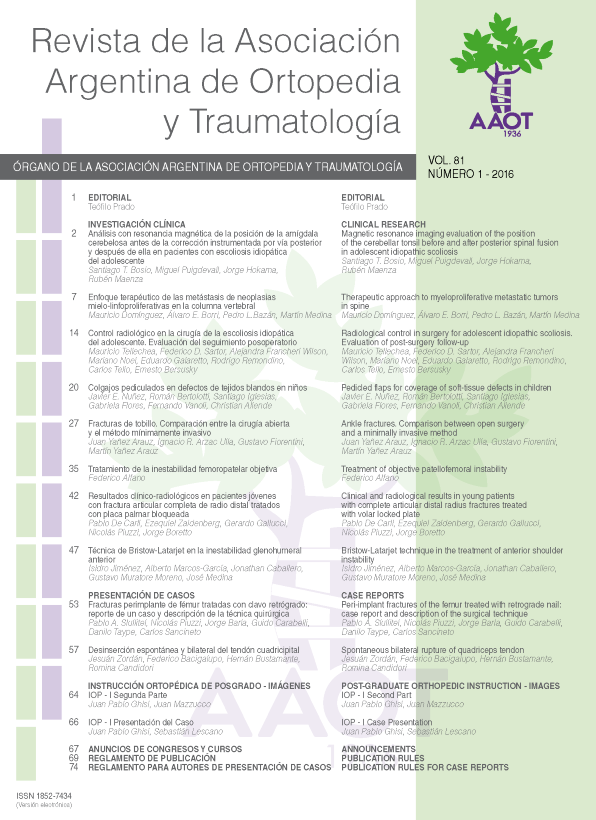Magnetic Resonance Imaging Evaluation of the Position of the Cerebellar Tonsil before and after Posterior Spinal Fusion in Adolescent Idiopathic Scoliosis
Main Article Content
Abstract
Downloads
Metrics
Article Details

This work is licensed under a Creative Commons Attribution-NonCommercial-ShareAlike 4.0 International License.
Manuscript acceptance by the Journal implies the simultaneous non-submission to any other journal or publishing house. The RAAOT is under the Licencia Creative Commnos Atribución-NoComercial-Compartir Obras Derivadas Igual 4.0 Internacional (CC-BY-NC.SA 4.0) (http://creativecommons.org/licences/by-nc-sa/4.0/deed.es). Articles can be shared, copied, distributed, modified, altered, transformed into a derivative work, executed and publicly communicated, provided a) the authors and the original publication (Journal, Publisher and URL) are mentioned, b) they are not used for commercial purposes, c) the same terms of the license are maintained.
In the event that the manuscript is approved for its next publication, the authors retain the copyright and will assign to the journal the rights of publication, edition, reproduction, distribution, exhibition and communication at a national and international level in the different databases. data, repositories and portals.
It is hereby stated that the mentioned manuscript has not been published and that it is not being printed in any other national or foreign journal.
The authors hereby accept the necessary modifications, suggested by the reviewers, in order to adapt the manuscript to the style and publication rules of this Journal.
References
2. Eule J, Erickson M, O'Brien M, Handler M. Chiari I Malformation Associated with Syringomyelia and Scoliosis: A Twenty-Year Review of Surgical and Nonsurgical Treatment in a Pediatric Population. Spine 2002;27(13):1451-1455.
3. Aboulezz AO, Sartor K, Geyer CA, et al. Position of cerebellar tonsils in normal population and in patients with Chiari malformation: a quantitative approach with MR imaging. J Comput Assist Tomogr 1985;9:1033–6.
4. Barkovich AJ, Wippold FJ, Sherman JL, et al. Significance of cerebellar tonsilar position on MR. AJNR Am J Neuroradiol 1986;7:795–9.
5. Ghanem IB, Lodono C, Delalande O, et al. Chiari I malformation associated with syringomyelia and scoliosis. Spine 1997;22:1313–8.
6. Dyste GN, Menezes AH. Presentations and management of pediatric Chiara malformations without myelodysplasia. Neurosurgery 1988;23:589–97.
7. Brockmeyer D, Gollogly S, Smith J. Scoliosis associated with Chiari I malformation: the effect of suboccipital decompression on scoliosis curve progression. A preliminary study. Spine 2003;28(22):2505-2509.
8. Lenke L, Betz R, Harms J, et al. Adolescent idiopathic scoliosis: a new classification to determinate extent of spinal arthrodesis. J Bone Joint Surge Am 2001;83A:1169-81
9. Inoue M, Minami S, Nakata Y, et al. Preoperative MRI analysis of patients with idipathic Scoliosis. A prospective study. Spine 2004;30(1):108-114.
10. Cheng JCY, Guo X, Sher AH, et al. Correlation between curve severity, somatosensory evoked potentials, and magnetic resonance imaging in adolescent idiopathic scoliosis. Spine 1999;24:1679–84.
11. Porter RW, Hall-Craggs M, Walker AE, et al. The position of the cerebellar tonsils and the conus in patients with scoliosis. J Bone Joint Surg Br 2000;82(suppl 3):286 –7.
12. Spiegel DA, Flynn JM, Stasikelis PJ, et al. Scoliotic curve patterns in patients with Chiari I malformation and/ or syringomyelia. Spine 2003;28:2139 – 46.
13. Cheng JC, Chau WW, Guo X, et al. Redefining the magnetic resonance imaging reference level for the cerebellar tonsil: a study of 170 adolescents with normal versus idiopathic scoliosis. Spine 2003;28:815–8.
14. Sun X, Qiu Y, Zhu Z, Zhu F, et al. Variation of the position of the cerebellar tonsil in idiopathic scoliosis with Cobb angle > 40º. A magnetic resonance imaging study. Spine 2007;32(15):1680-1686.

